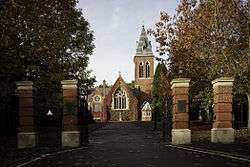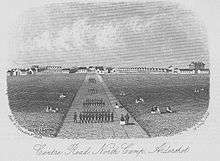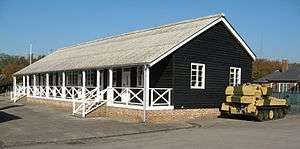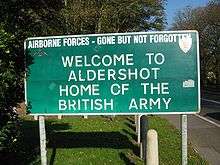Aldershot Garrison
| Aldershot Garrison | |
 All Saints Royal Garrison Church |
|
 Aldershot Garrison |
|
| Population | 10,500 |
|---|---|
| District | Rushmoor |
| Shire county | Hampshire |
| Region | South East |
| Country | England |
| Sovereign state | United Kingdom |
| Post town | ALDERSHOT |
| Postcode district | GU11 |
| Dialling code | 01252 |
| Police | Hampshire |
| Fire | Hampshire |
| Ambulance | South East Coast |
| EU Parliament | South East England |
| UK Parliament | Aldershot |
Coordinates: 51°15′36″N 0°45′35″W / 51.2599°N 0.7598°W
Aldershot Garrison, also known as Aldershot Military Town, is a major garrison in South East England, located between Aldershot and Farnborough in Hampshire. Established in 1854, Aldershot has long been seen as the home of the British Army. The garrison was established when the War Department bought a large area of land near to the village of Aldershot, with the objective of establishing a permanent training camp for the British Army. Over time, this camp grew into a military town and continues to be used by the Army to the present day. It is home to the headquarters of the Army's Support Command, and it is also the administrative base for the 101st Logistic Brigade. The garrison plays host to around 70 military units and organisations.
In 1972, the garrison was the site of one of the worst UK mainland IRA attacks of the time when a car bomb was detonated outside the headquarters mess of 16 Parachute Brigade. The Official IRA claimed responsibility, stating that the attack was in revenge for the shootings in Derry that came to be known as Bloody Sunday. At the time of the attack, Aldershot garrison was an entirely open garrison. Following the attack the Army took steps to secure the garrison by erecting security fences around most of the barracks and lines, as well as introducing armed security patrols.
The Garrison area covers approximately 500 acres. The total garrison population is about 10,500. Adjacent to the military town is some 2,700 hectares of open military training area. Aldershot Garrison will serve as the hub for the future South East Super Garrison, which will include satellite establishments at Minley, Bordon, Sandhurst, Pirbright, Deepcut, Keogh, Arborfield, Winchester and Worthy Down.
History
Established in 1854, Aldershot has long been seen as the home of the British Army.[1] The garrison was established when the War Department bought a large area of land near to the village of Aldershot, with the objective of establishing a permanent training camp for the British Army. Over time, this camp grew into a military town and continues to be used by the Army to the present day.
Beginnings

Before the establishment of the 'Camp at Aldershot', the British Army did not have any single permanent camp for training troops on a large scale. Historically, troops had been stationed in long established garrisons, many of which could trace their histories back as mediaeval, or earlier, defensive positions. In 1852, following the death of The Iron Duke, a group of reformers, which included Prince Albert, forged an alliance that would seek to improve the training of the Army.[2] In 1853, a summer camp was established at Chobham Common and two divisional size military exercises were conducted. Following the success of these manoeuvres, it was decided that a permanent camp was needed where such exercises could be regularly conducted. Initially, Reigate was selected as a location that was strategically sound, and close enough to London, to defend against invasion from across the English Channel. Despite its obvious advantages, Reigate was situated in prime agricultural land that would prove too expensive to purchase. Lord Hardinge suggested Aldershot Heath as the location for the new training area, as land was less expensive, but still close enough to the South Coast to defend London.[2] In January 1854, the British Government's War Department purchased areas of heathland around the small village of Aldershot at £12 an acre. By 1861, around 8,000 acres had been purchased.[3]
It was originally only envisaged to set up a tented camp for summer use; however, following the outbreak of the Crimean War, it was necessary to accommodate a large number of troops, over a longer period of time and so two hutted camps, one north and one south of the Basingstoke Canal, were constructed. Between 1854 and 1859, around 1,200 wooden huts were constructed by a local civilian contractor, at a cost of £100,263.[4]

Queen Victoria and Prince Albert showed a keen interest in the establishment and the development of Aldershot as a garrison town. In 1855, they had a wooden Royal Pavilion built, in which they would often stay when attending reviews of the Army.[5] In 1860, Prince Albert established and endowed the Prince Consort's Library, which exists to this day.
After the Crimean War, a division of regular troops was permanently based at Aldershot, and ‘the Division at Aldershot’ (including artillery at Christchurch, Hampshire, and cavalry at Hounslow, Middlesex) became one of the most important home commands of the British Army.[6] In January 1876 a Mobilization Scheme for the forces in Great Britain and Ireland was published, with the Active Army divided into eight army corps based on the major Commands and Districts. The 2nd Corps was headquartered at Aldershot. This scheme disappeared in 1881, when the districts were retitled ‘District Commands’, with Aldershot usually listed as IX or X. In 1898, (when Queen Victoria’s son, the Duke of Connaught, was General Officer Commanding) Aldershot Command was ranked I on the list. From 1901 to 1908 Aldershot Command was given the additional title of I Army Corps.
The garrison subsequently became seen as home to the British Army.[1] This status has been reflected in the use of Aldershot as a headquarters for a variety of regional commands over the last 100 years. HQ Aldershot Command continued in existence until c. February 1941, when it was replaced by HQ Aldershot Area.
In the 19th century

In the late 1870s, it was decided that the original hutted camp needed to be replaced with some more permanent structures. When the wooden huts had been built in the 1850s, the contractor had guaranteed the huts for 13 years; in practice, many of those huts were still serving their purpose some 30 years later. In November 1881, the first steps were taken to convert the hutted camp into permanent barracks. At this time, the first two brick buildings were constructed in North Camp; this was quickly followed by the construction of a number of larger brick-built bungalows to replace the previous wooden designs.[7] Government House was built as the garrison commander's house in 1883.[8] Between 1889 and 1893, the remaining wooden buildings, in both North Camp and South Camp, were replaced by brick buildings. Field-Marshal Sir Evelyn Wood had recently been appointed General Officer Commanding at Aldershot and was keen to push forward the building of the new accommodation. It was also, at his request, that a convention for naming the barracks was formulated. Wood advocated that the new barracks should all be named to commemorate famous British victories; initially this proposal met with some resistance, but was eventually adopted. The barracks in Stanhope Lines took names from the famous battles of the Napoleonic Wars and those in Marlborough Lines took names from Marlborough's campaigns.[9]
In the 20th century
The garrison used to be the corps headquarters for the Royal Corps of Transport and the Army Catering Corps; when these were merged into the Royal Logistic Corps in 1993, the corps headquarters moved to Deepcut Barracks. The garrison was also home to The Parachute Regiment from its formation in 1940 until the regiment moved to Colchester Garrison in 2003. Today, the garrison is home to the headquarters of the Support Command of the British Army, and is also the administrative base for the 145th (South) Brigade and 101st Logistic Brigade. The garrison plays host to around 70 military units and organisations.[10]
1972 IRA bombing
On 22 February 1972, Aldershot experienced one of the worst UK mainland IRA attacks of the time. Seven people, all civilian support staff, including cooks, cleaners, and a Catholic priest, were killed and 19 people were injured, in a car bomb attack on the 16th Parachute Brigade headquarters mess at Aldershot garrison. This blast was later claimed, by the Official IRA, as revenge for the shootings in Derry that came to be known as Bloody Sunday.[11] Until then, the military town had been open-plan, but the attack led to immediate action to secure military property by erecting security fences topped with barbed wire. Other security measures, including armed patrols were also implemented.
Following the bombing, it was decided to erect a memorial plaque in the grounds of a prominent new building approximately one mile away in Aldershot's town centre. However, this was soon rejected, and once the attacked building was demolished, the plaque was moved to its current position, on the site of the bombing. The grounds and the site of the memorial have been preserved by the Army ever since.
Barracks, buildings and geography


Historical military town
Following Aldershot's establishment as a large permanent training camp in the 1850s, the military presence continued to grow. The garrison was divided into the North Camp and the South Camp, either side of the Basingstoke Canal. As more soldiers arrived, they were first housed in bell tents due to a shortage or permanent accommodation. Later, wooden huts were built, which were in turn replaced by brick built barracks in the 1890s. Much of the Victorian camp was demolished in the 1960s.[12]
North Camp
Prior to 1890, Aldershot garrison lacked permanent accommodation to house the growing military presence. Following the Barracks Act of 1890, North Camp was rebuilt with brick barracks named: Blenheim, Lille, Malplaquet, Oudenarde, Ramillies and Tournay. The new barracks were built by Henry Wells, a locally based building contractor. This group of barracks then became known as the Marlborough Lines.[12] Today, the only surviving barracks of the Marlborough Lines group is Lille barracks. The Victorian buildings were largely demolished in 1958, and then rebuilt with more modern facilities, although the original officers' mess survives.[13] North Camp station is the garrison's original railway station.
South Camp
Like North Camp, the area known as South Camp was rebuilt at much the same time. Construction was completed by the same local company responsible for Marlborough Lines. This phase of construction saw nine barracks built, namely those of: Albuhera, Barossa, Corunna, Gibraltar, Maida, Buller, Mandora and McGrigor barracks. This group of barracks became known as Stanhope Lines. Many of these brick-build Victorian barracks were demolished in the late 1960s, to make way for what is now Montgomery Lines. One of the Victorian barracks did survive; Clayton barracks is presently used as a transit camp to house soldiers attending Aldershot garrison on courses, or for sporting events and training. Montgomery Lines was completed in the 1970s and was built on the site of several barracks that formerly made up Stanhope Lines. Buller barracks also survives today, although the original Victorian barracks were demolished in the late 1960s, it was rebuilt in the 1970s.[12]
Modern military town

Today, the military town has a population of around 10,500. This consists of around 3,900 resident soldiers, some 1,000 transient military personnel on courses or sport, 770 MoD Civil Servants and some 5,000 service dependents. The garrison contains 2,145 Service Family Accommodation quarters. The rest of the garrison comprises barracks, the Aldershot Military Stadium, Queen's Parade playing fields, Garrison Sports Centre and the Aldershot Centre For Health, which is a joint MoD and local authority venture. The garrison is mostly centred around the crossroads that join Queen's Avenue and Alison's Road. The military town includes local landmarks such as the Aldershot Observatory, Wellington Statue, the RAMC Memorial, Aldershot Military Cemetery, the Royal Garrison Church and other churches. Adjacent to the military town is some 2,700 hectares of open military training area, which is open to the public when not in use for military purposes.[10]
Brigades, regiments and units
Under Army 2020, the units based here are:[14]
- HQ 101st Logistic Brigade
- HQ 11th Infantry Brigade and Headquarters South East
- 1st Battalion, Grenadier Guards
- 1st Battalion, Scots Guards
- 4th Battalion, The Rifles
- 3 Regiment RLC
- 4 Armoured Medical Regiment
- 4 Regiment RMP
- 10 Queen's Own Gurkha Logistic Regiment RLC
- 29 EOD & Search Group
- 22 Field Hospital
Also at Aldershot is the Army School of Physical Training, which is the headquarters of the Royal Army Physical Training Corps.[15]
Future development
South East Super Garrison
The Army selected Aldershot garrison as the hub of the new South East Super Garrison, which will include satellite establishments at Minley, Bordon, Sandhurst, Pirbright, Deepcut, Keogh, Arborfield, Winchester and Worthy Down.[16]
Aldershot Urban Extension
In recent years, plans were unveiled for local government and planners to redevelop some of the land that comprises the military town according to Aldershot's Urban Extension or 'AUE'.[17] In August 2007, a request was made by Hampshire County Council to Aldershot magistrates to extinguish highway rights from Defence Estates, of Pennefathers Road (the site of the 1972 bombing) as a public road. Although the road has been closed with controlled access since the attack, it was recently decided that, with impending redevelopment, it would be necessary to 'formalise the closure'.
See also
- List of British Army Garrisons
- List of army barracks around Aldershot
- Aldershot Command
- Letter from Aldershot, a 1942 Canadian propaganda short set at Aldershot Garrison
References
- 1 2 Origins of the Military Town
- 1 2 Vickers, Paul H. (2011). Aldershot Military Town—a brief history. Friends of the Aldershot Military Museum. p. 1.
- ↑ Cole, Howard N. (1980). The Story of Aldershot. Southern Books. p. 29. ISBN 0-950-7147-0-4.
- ↑ Vickers, Paul H. (2011). Aldershot Military Town—a brief history. Friends of the Aldershot Military Museum. p. 2.
- ↑ Cole, Howard N. (1980). The Story of Aldershot. Southern Books. p. 45. ISBN 0-950-7147-0-4.
- ↑ Hart’s Army List from 1857
- ↑ Cole, Howard N. (1980). The Story of Aldershot. Southern Books. p. 86. ISBN 0-950-7147-0-4.
- ↑ "Government House Mess, Farnborough". British listed buildings. Retrieved 1 August 2015.
- ↑ Cole, Howard N. (1980). The Story of Aldershot. Southern Books. p. 87. ISBN 0-950-7147-0-4.
- 1 2 Aldershot Garrison, Introduction
- ↑ "IRA bomb kills six at Aldershot barracks", bbc.co.uk. Retrieved 1 March 2011.
- 1 2 3 Guide to the barracks of Aldershot
- ↑ History of Lille Barracks
- ↑ "Transforming the British Army: an update" (PDF). Ministry of Defence. Retrieved 6 May 2016.
- ↑ "Royal Army Physical Training Corps - How to find us". army.mod.uk. Retrieved 23 October 2016.
- ↑ South East Super Garrison
- ↑ Aldershot's Urban Extension
External links
| Wikimedia Commons has media related to Aldershot Garrison. |